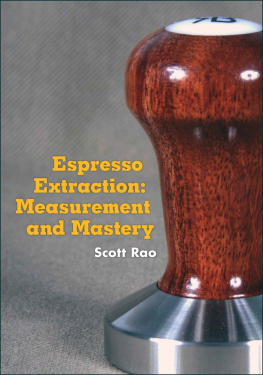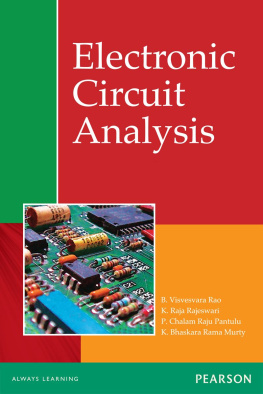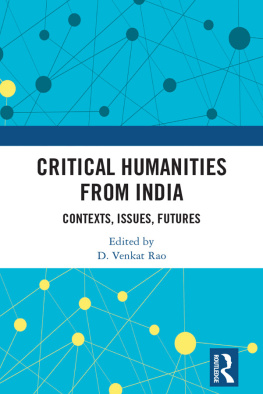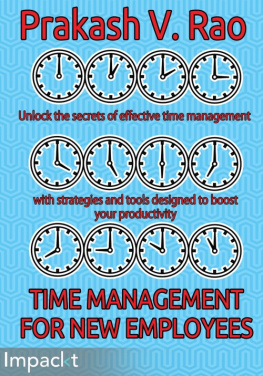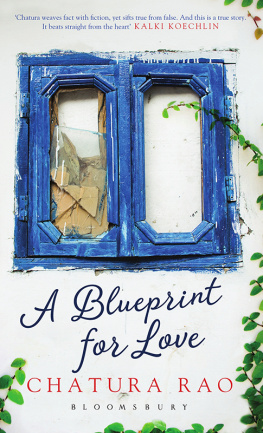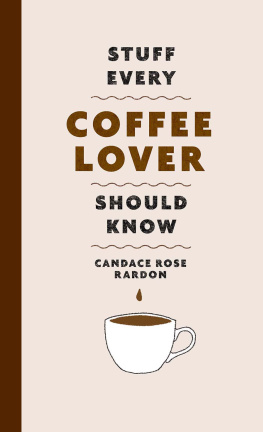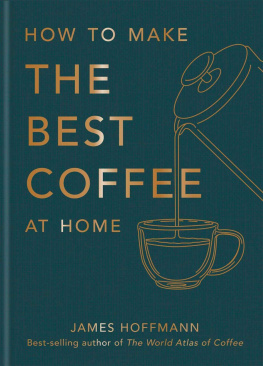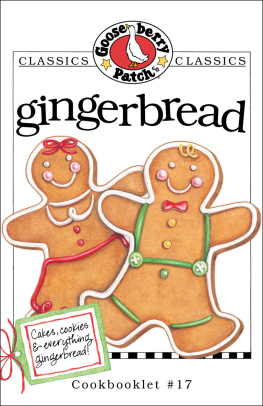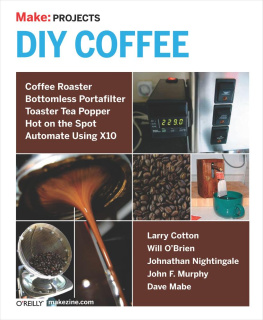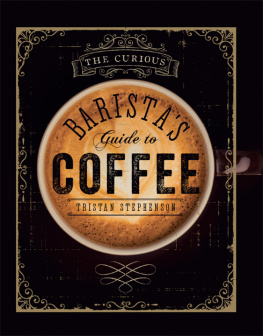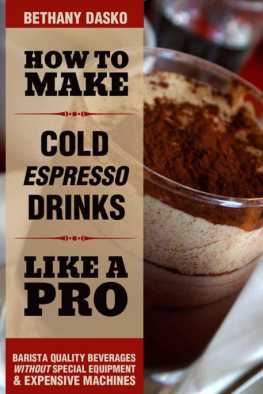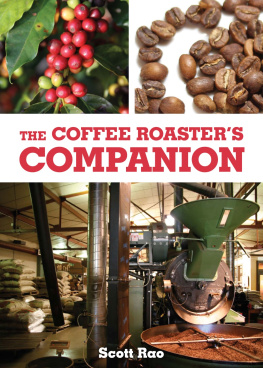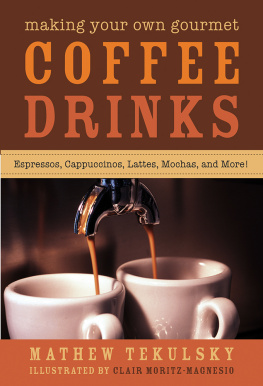Espresso Extraction: Measurement and Mastery
Scott Rao
Published by Scott Rao
Copyright Scott Rao, 2013
Photography by Liz Clayton
Edited by Jean Zimmer
Cover design by Rebecca Neimark
E-Book formatting:
All rights reserved. No part of this book may be reproduced or transmitted in any form, by any means (electronic, photocopying, recording, or otherwise) without the prior written permission of the author. No liability is assumed with respect to the use of the information contained within. Please purchase only authorized electronic editions and do not participate in or encourage electronic piracy of copyrighted materials. Although every precaution has been taken, the author assumes no liability for errors or omissions. Neither is any liability assumed for damages resulting from the use of the information contained herein. Names and personal characteristics of some individuals, as well as the chronology of certain events, have in some cases been changed. Some individuals are invented and any resulting resemblance of these individuals to persons living or dead is entirely coincidental and unintentional.
The author has taken care in preparation of this book but assumes no responsibility for errors or inaccuracies.
Preface
In my 20 years in the coffee business, Ive seen a mere handful of cafs provide all the conditions necessary to produce a great espresso. My goal in writing this book is to teach baristi what those conditions are, how to optimize them, and how to ensure the result is a great espresso.
This book is not written for the novice barista; at the minimum, a reader should have several months of espresso-making experience and a basic understanding of the technical aspects of espresso extraction. As well, I strongly recommend reading and understanding The Professional Baristas Handbook, my comprehensive guide to espresso preparation, before tackling this work. The Professional Baristas Handbook provides a technical foundation that lets you better take advantage of the information in this book.
Introduction
Consistently producing ideal espresso extractions is fiendishly difficult. Simply to get the opportunity to pull a great shot, a barista must optimize numerous variables. Once a barista addresses those variables, she still must skillfully execute several actions to produce an ideal extraction.
Although barista skill and a little luck sometimes combine to create a fabulous espresso, being able to consistently produce delicious coffee requires both skill and the use of quality tools. These tools include a coffee refractometer, well-made baskets, and a grinder with large, sharp burrs. Baristi who avoid using all of these tools often make excuses implying that a baristas skill is all that is needed to pull great espresso.
Many baristi are uncomfortable with measuring extraction or with implementing systems to ensure consistent results. They seem concerned that such ideas take power out of the hands of the barista, but they shouldnt be concerned. While the past few years have seen the invention of the coffee refractometer, VST baskets, and machines with programmable pressure profiling, those years have also seen an unprecedented increase in the status and respect accorded to baristi. The wise barista will realize that the more tools and technologies he has at his disposal, the more ability he will have to control the quality of his coffee, and the more respect he will ultimately receive. No matter how much baristi take advantage of tools and technology, there will always be a place for judgment and skill in espresso making.
Chapter 1
What Is an Ideal Extraction?
Below, I define an ideal extraction based on parameters that are rapidly becoming the industry standards for espresso normale:
Dry Dose
The dry dose should weigh between 14 and 22 g and should approximate the dose a given basket is designed to hold (i.e., within 10% of the baskets intended dose).
Brewing Ratio
Shot weight should be approximately 1.5 to 2.0 times the weight of the dry dose. I consider lower ratios to be ristretto and higher ratios to be lungo espresso.
Temperature
Water temperature at the group head should be 195F to 203F (91C to 95C). Generally, the lower temperatures in that range should be used for higher brewing ratios (more lungo), and higher temperatures should be used when brewing with lower ratios (more ristretto). Coffee origin, processing, and roast degree also influence the water temperature the barista should use.
Time
Time elapsed from the moment a barista starts flow from the group until the barista stops the flow should be 25 to 40 seconds. Baristi using flat pressure profiles should aim for the low end of the time range. Those pulling shots with progressive preinfusion should aim for the middle of the range, and baristi producing extractions using pressure profiling machines should target the top end of the time range. (See Chapter 11, Pressure Profiling.)
Extraction
Baristi will usually find that extractions in the 19% to 20% range yield the best-tasting shots. Please note three exceptions to this recommended range:
- Very large burr sets, when sharp, may produce fantastic shots at extractions greater than 20%. However, I do not recommend extractions greater than 20% for baristi who use most of todays popular espresso grinders.
- Small or dull burrs may necessitate extractions below 19% to avoid excessive astringency and bitterness.
- A barista seeking a clean, fruit-forward, bright shot may choose to extract in the 15% to 16% range (a.k.a. the little hump; see www.jimseven.com/2010/11/08/the-double-hump). Such shots emphasize fruitiness at the expense of caramels and balance and can be interesting and enjoyable as straight espresso. (Please note: Some experts argue that the little hump is merely an artifact of a common extraction calculation error. I am confident that the little hump is real and not the result of an error.)
But What about Taste?
While reading this book, you may decide that my ultimate goal is to pull a shot at x extraction and y strength. Its not; my goal is to make the most delicious coffee I can. But while discussing what is delicious is devilishly difficult, describing the data that denote deliciousness is not. So Ill stick to explaining the espresso-making process, how to measure results, and how to make use of the measurement data. Ill leave it up to the reader to decide how to apply these ideas to suit his or her taste.
While I dont recommend relying solely on data, I also dont recommend that baristi rely on taste alone to decide how to make espresso. The problem with relying solely on taste is that many variables in the espresso-making process have nonlinear effects. These nonlinear effects make it nearly impossible to find the optimal set of adjustments through trial and error guided by taste alone.
For example, if a barista pulls a shot and does not like the flavor, he may try using a finer grind. If he decides he liked the first shot better, he will then revert to using a coarser grind. However, its possible the barista should have made the grind even finer to optimize the coffees flavor. How could that be? Lets say the first shot was a 17.0% extraction. Espresso is typically sour and unremarkable at 17.0%. The shot with the finer grind may have been 17.7% and perhaps marginally worse-tasting than the first shot. Had the barista made the grind finer again to create an 18.5% extraction, he would have noticed an increase in ripeness and caramels and a decrease in sourness. Such nonlinear changes in quality are the norm in coffee extraction. Therefore, a barista who is guided by taste may dial in a shot by fiddling with various parameters, but its nearly impossible for him to know whether he has settled on the best possible set of parameters.
Next page
